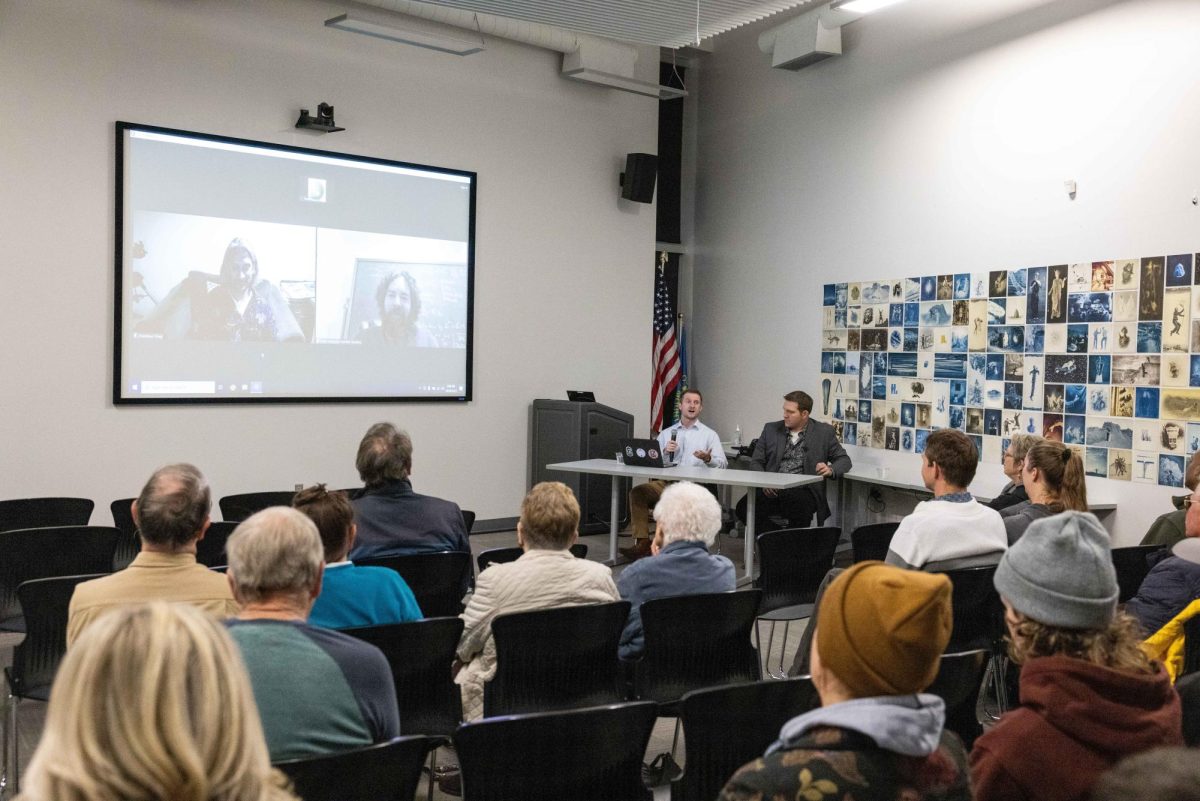Around the world, scientists and labs are celebrating Dark Matter Day. The celebration started in 2017 and is held annually on and around Oct 31. This year, about 16 events are being held worldwide. Sanford Underground Research Facility (SURF) was among the first to host an event at the Sanford Lab Homestake Visitor Center in Lead, SD.
The event started at 5:00 with a social hour, and light snacks were provided. Crow Peak Brewing Company offered attendees local beer. Crow Peak Brewing Company has been a significant sponsor of the Deep Talk series since its inception. During the social hour, locals and SURF scientists struck up conversations. Most of the conversations revolved around the experiments being done underground, the history of the mine, and some chatter about the weather. Even though it was the first cold day of the season, the turnout for the event was more than expected.
Afterward, everyone went to the conference room to listen to a panel about Dark Matter and how a theory becomes an experiment. The panelists included Cham Ghag, spokesperson for the LUZ-ZEPLIN Detector (LZ); Pedro Machado, Fermilab scientist and theorist; and Charles Maupin, SURF engineer. Gavin Cox, experiment support scientist at SURF, served as panel moderator.
The first question was, “How does theory become an experiment?”
“First, you present data that does not explain our current model of the universe. From a theorist’s side, several theoretical arguments will lead to nicer theories. If you have a theory of dark matter that can explain other outstanding questions in the universe, let’s say the mass of neutrinos, then this becomes a more interesting and robust theory. Then, there is an experimental element to this. You want to respect observations that have already been made and eventually make more predictions based on this that you can experiment with in the lab,” said Pedro.
“How do experimentalists design an experiment to test the dark matter theory?” Gavin said.
“In the case of dark matter, there is a favored theory, Weakly Interacting Massive Particle called WIMP for short. We can break it down; the massive particle part is that we are seeing something happening out there in the cosmos. Things are moving around in orbits with velocities that are way too fast. It’s as if something is holding them in, some kind of glue or matter. Something with mass that’s the only way we can explain it. But the weakly interacting part is interesting because it doesn’t have to have a weak interaction. Dark matter may not have an interaction at all. In this case, it can be very difficult to detect. If we look at the standards of particle physics, then it’s clear that there is more out there than is explained in this model. Occasionally, a dark matter particle that is a WIMP will interact with a nucleus of an atom and will move that nucleus by about 1000th of a hair’s width. So that’s what we are trying to detect. When it comes to designing the experiment, you want the detector to be large because you want as many dark matter particles streaming through this detector as possible with the hope of an interaction. You want it to be highly sensitive so that if anything does interact, you are able to spot it,” Cham said.
LZ is currently the world’s most sensitive dark matter detector. It is located 4,850’ underground at SURF to protect it from cosmic radiation that would interfere with dark matter signals. The materials used to build the experiment had to be pure and not interact with the detector in any way. Every material was screened for radioactivity. They used the world’s purest titanium to build the chamber containing 7 tons of liquid xenon.
The experiment was meticulously designed and engineered to be installed underground. Many parts of LZ were assembled above ground in a clean room and transferred underground. Some parts just barely fit down the shaft. The 9-foot-tall, 5,000 lb. inner detector of LZ took 45 minutes to reach the 4800’ level compared to a ride that typically takes 13-15 minutes. This was just one of the many steps to complete the construction of the detector.
“LZ taught us a lot of lessons about how to handle sensitive equipment, and that can be directly applied to future experiments. We have DUNE (Deep Underground Neutrino Experiment) coming to SURF. Everything will be delivered on the surface and will need to go underground. The pieces for DUNE are different, but the same techniques can be used. With new larger experiments, there remains the challenge of the larger pieces that will need new manufacturing techniques to allow large pieces to be built underground,” Charles said.
SURF will continue its Deep Talk Series on Nov. 9 at the Sanford Lab Homestake Visitor Center with Dr. Katrina Donovan, a lecturer in the Department of Materials and Metallurgical Engineering at South Dakota Mines. Her talk is titled “Art and Engineering at South Dakota Mines.”


